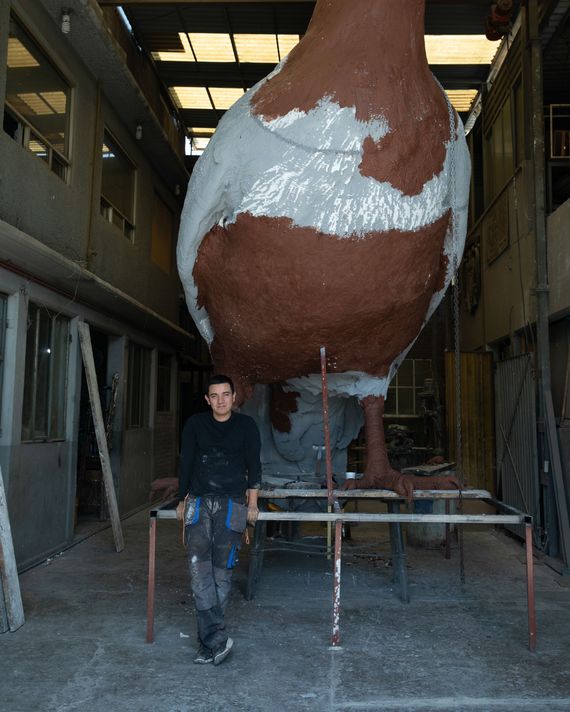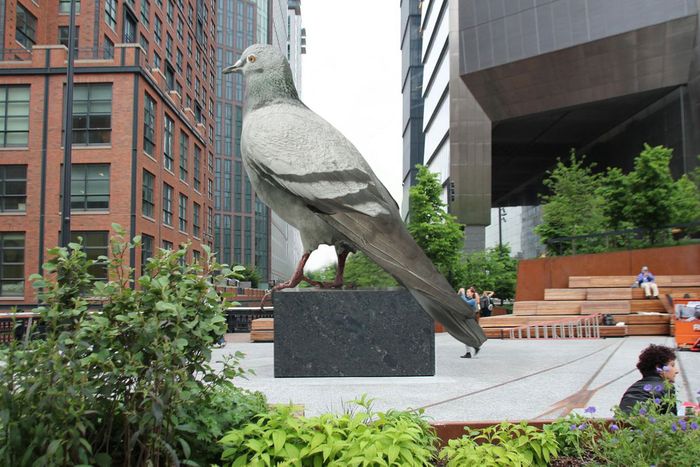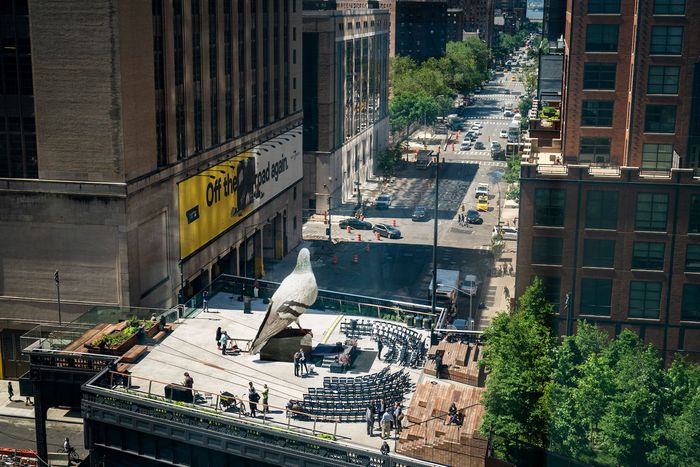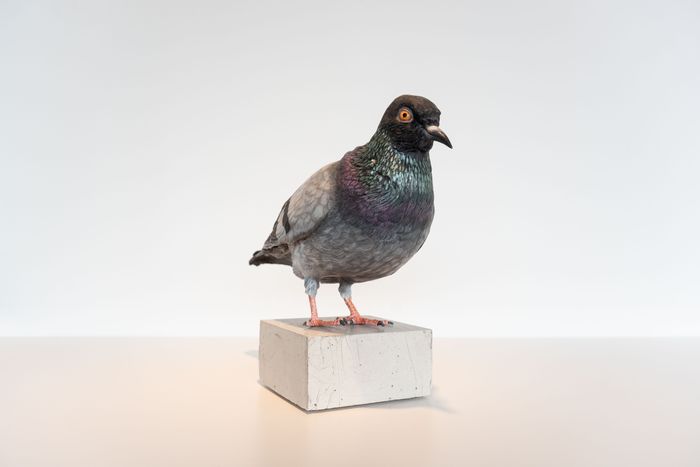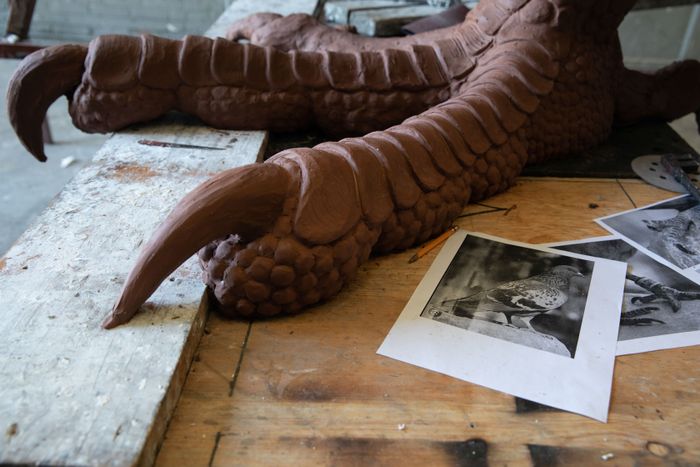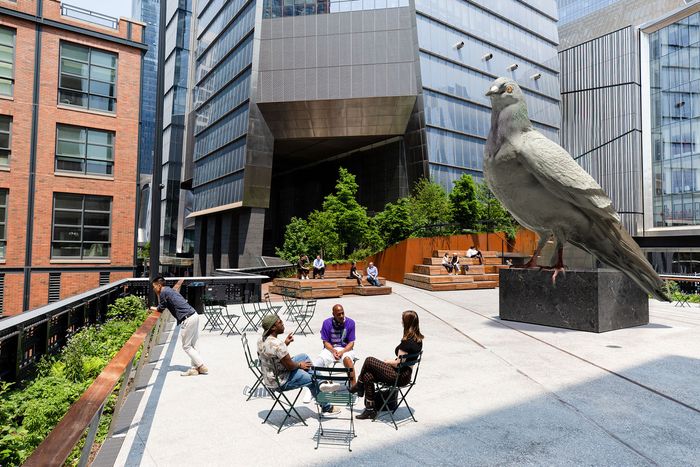Iván Argote’s Big Pigeon Sculpture To Land on the High Line

The pigeon has landed. Or, it will soon. Right now it’s being hatched in Mexico.
Photo: Courtesy Iván Argote / The High Line
This fall, a 16-foot-tall pigeon — its chest puffed out proudly, head high, not down pecking at some distaff pizza crust, its pitiless red-eye gaze looking out over the traffic — will alight on the spur of the High Line that bridges Tenth Avenue at 30th Street. The pigeon’s name, or at least the title of the work, is Dinosaur. “I hope it doesn’t cause any accidents,” says Iván Argote, the artist who created it. “But when you’re driving, it really attracts your eye. You look up and are just like, What?”
Dinosaur will be an avatar of large-scale pigeonness, something there isn’t a lot of in art history or anywhere else, really. Pigeons have never been thought of as heroic. Far from it. They are the world’s oldest domesticated bird, mentioned on Mesopotamian cuneiform tablets and in Egyptian hieroglyphics dating back 5,000 years. It wasn’t ever really an equal interspecies relationship: Mostly, humans kept them around for food or, thanks to their homing instinct, for carrying messages. Prettier breeds were decorative pets. Others are still raised to race. Mostly these days, having escaped their lives in human servitude and gone feral, they are considered lowborn urban poop machines — greasy, scavenging unthreatening “rats with wings.” People feed them, whether they mean to or not, and hawks eat them.
Which is why pigeons, unlike, say, imperial eagles, or regal lions, or, of course, horses preening with humans atop them, rarely get this sort of exalted treatment. Nobody takes pigeons all that seriously: They are background animals, their gray bodies blending in with the dirty pavement they flock across, pecking around for whatever humans drop on the ground. Which is entirely the point that Argote was making in proposing it for the perch atop the High Line Plinth.
The artist with the bird at the foundry in Mexico where it was hatched.
Photo: Yvonne Venegas; Courtesy Iván Argote and the High Line
Argote, 40, is Colombian but has mostly lived and worked in Paris since he was 22. He found when he moved there statues and monuments that, if you bother to look as he did walking its squares, glorified the perpetrators of violence, subjugation, and conquest. He decided to do something about that: monument mitigation through “illegal or almost illegal interventions, or adding things to colonial sculptures in Colombia and Madrid, and in other countries,” he says. “It was not systematically, but it was kind of this pattern — follow the stories of some of these characters, and I end up meeting them in places, such as Christopher Columbus or other conquistadors in South America.”
Don’t worry, it doesn’t poop.
Photo: Courtesy Iván Argote / The High Line
In one 2011 series, he took photographs of various equestrian monuments around Paris–and other cities including New York–and digitally erased the people riding on top of them. The series, which re-centered the honor on the horse, was called Horses. The next year, while traveling in Madrid, he began a series called Turistas where he dressed colonial statues of kings and conquistadors in ponchos. He also initiated a project where he would surround a statue with a mirrored box, reflecting the world around it, absent its presence. In 2021, he rolled a crane up to a statue of a particularly problematic man in Paris and created a video, titled Aurevoir Joseph Gallieni, of its being removed, although the “removal” was only done digitally in post-production, not IRL. Still, the faked images caused a bit of a stir.
“I had pigeons in my life, yeah,” he says. “And in my work before. It came from different places.” Paris is a city of pigeons. “I like to contemplate the city. Then, somehow, I felt at some point like the pigeons around and then I felt this kind of company,” he says. “In those days, even before I started doing the rest of the monuments, I was thinking, What could be a pigeon monument, a monument for a pigeon?”
Photo: Courtesy Iván Argote / The High Line/2019 Getty Images
When he was nominated to make a proposal for the High Line Plinth, he was intrigued, but “it was hard because I spend my time trying to remove things out of pedestal,” he says. “For a long time, I was a bit lost.” At first, he spent time on a proposal that was “more related to all these decolonial or postcolonial ideas.” Something with a clear message. However, “I felt was very boring,” he says. “Most of the time, we place humans on top of this pedestal. Then, my response was not to play the human card but to play the nonhuman one.”
And so he decided to try the pigeon, despite his fear that it might not be considered as serious. “I kind of got honest with myself. I think when you do these kinds of projects, you have a certain kind of responsibility. This is not about your work and your research. It’s also about what you can transmit the way you can, the reactions you can generate, mostly in public space. And then I saw the pigeon would be something that people would react to in different ways. It’s a very iconic animal or entity, or icon of New York, and also still a marginal creature, living in dirty corners. You see a lot of people who live in the street or have to spend most of their lives in the street; they also get a sort of love or closeness with these pigeons. Sometimes the pigeons do very human stuff, like take the subway. So I think you can recognize yourself in them.”
His original maquette — which was on view at the High Line along with the other 12 finalists in 2021 — looked rather like a stiff toy pigeon that child might make. “If you look at the original maquette, it was just literally a model of a pigeon sitting on the plinth,” he says.
The artist’s starter bird. It evolved from here.
Photo: Timothy Schenck/Courtesy Iván Argote/the High Line
After his idea was selected, he had to evolve it to the proud — even arrogant — bird that it has become, talons gripping the front of the plinth, tail swept back and to one side to give it the third point of support so that it does not fall over — or fly away — in the wind. The feet had to be splayed out, too, gripping the edge of the box. (The tail straight out in the maquette would have been an obstacle and it had to perch.) The shifting is not quite avian contrapposto: “It’s like when sometimes they take a picture of you and then the photographer tells you to be three-quarters and look at the camera,” Argote says.
It went through many rounds of refinement in clay as Argote rented and scanned various taxidermied pigeons and visited the collection of 19th-century wild-animal statuary at the Musée d’Orsay. “It’s a very kind of artistic approach,” he says. “We didn’t talk to a lot of ornithologists.”
A big bird foot.
Photo: Yvonne Venegas; Courtesy Iván Argote and the High Line
Dinosaur — which Argote declines to confine to the gender binary, explaining that the statue has elements of both male and female pigeons — was cast from aluminum in a foundry in Mexico. “We did many corrections, like the detail: It’s like, ‘Ah, but this wing doesn’t go this way. There is a little depression here in the chest. We have to fill it out, and fill this in,’” he says.
It will migrate (over land, as it has yet to learn how to fly) to its new perch in October, where it will sit for 18 months. Dinosaur will be the fourth occupant of the five-foot-square plinth since the program was inaugurated with Simone Leigh’s Brick House in 2019. “People [already] feel strongly about it. Some people really hate pigeons. Other people are completely obsessed,” says Cecilia Alemani, the director and chief curator of High Line Art. “It was interesting compared, for instance, to the beautiful piece that we have now, which is an amazing piece” — Pamela Rosenkranz’s pink-and-red Old Tree — “but it is something that usually people just love.” Over the next year and a half, the High Line is planning to engage the pigeon-appreciation community with pigeon-themed programming, especially around National Pigeon Day, June 13th.
I ask Argote what else he knew about the pigeon he’s hatched. How old is it? “It’s like a 35 … basically my age.” He wants to make it approachable, a sort of everypigeon, despite its size (21 feet tall, counting the plinth.) “I really want to have that feeling, like you know when sometimes you’re on your own for two seconds, or you’re having a sandwich in the street in between things, or just losing some time. Then, you look down, and there’s a pigeon there. Then, you have this kind of look at each other. I really want people to have that feeling. It’s like, Ah, I’ve seen you, man. Here you are. Here you are. You know, that guy in the corner that you say hello to but you don’t know much about him?”
But this sort of ignores the scale. Think of it from a normal-sized pigeon’s point of view. They probably won’t recognize Dinosaur as one of their own.
“I dream about the moment when the pigeon’s going to stand up on his head. I think that would be really an accomplishment in my life.”
A bird’s eye view.
Photo: Courtesy Iván Argote / The High Line
Don’t leave food around for it to eat.
Photo: Courtesy Iván Argote / The High Line
See All
Source link

